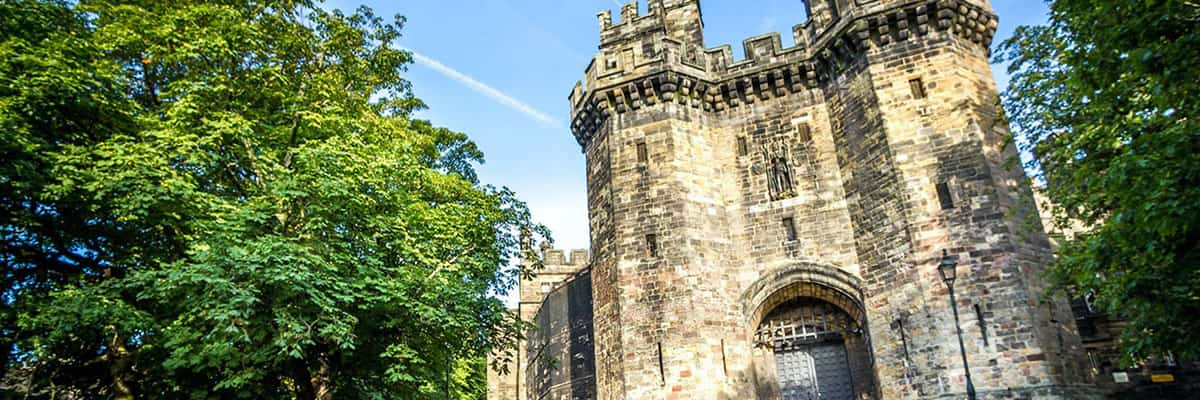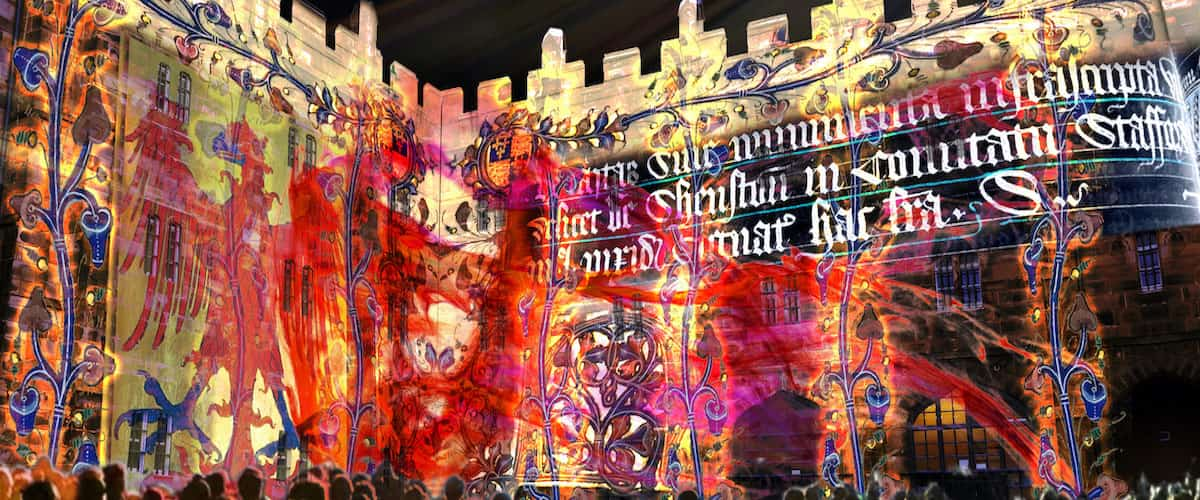
Records of the Medieval Duchy of Lancaster
The Duchy of Lancaster
The earldom of Lancaster was created in 1267 by King Henry III for his second son, Edmund. This came in the aftermath of England's first revolution, in which Simon de Montfort, Earl of Leicester, had seized power. The new earldom incorporated the Honour of Lancaster, based at Lancaster Castle, and the earldoms of Leicester and Derby, seized from disinherited Montfortians. To this great estate, the earldoms of Lincoln and Salisbury were added, in 1311, and then the Honour of Clitheroe, in 1348. This was an extensive, private land holding that brought swathes of the country's population and lands under the earl's jurisdiction. In 1351, the title 'Duke of Lancaster' was first bestowed on Henry Grosmont. His daughter Blanche married John of Gaunt, the second Duke of Lancaster. The heir to the Duchy, Henry Bolingbroke, seized the English throne in 1399, becoming Henry IV. He decreed that the Duchy should be held separately from all other Crown possessions and descend through the monarchy as a private estate. Today the estates of the Duchy belong to His Majesty the King and cover more than 18,228 hectares across England and Wales.


The Great Cowcher
In around 1402, King Henry IV commissioned the Great Cowcher Book: a record of land, titles and rights within the vast Duchy of Lancaster. The Cowcher includes copies of 2,433 documents written in Latin and French. This makes it second only to William the Conqueror's Domesday Book as a record of medieval landholding and the lives of ordinary people and communities in Medieval England. Unlike Domesday, though, it is richly illuminated. The scribes used precious inks to decorate the text and create captivating drawings of the earls and dukes across the centuries, as well as heraldic banners. The image here accompanies the Cowcher's first entry: a copy of Henry III's grant of the Honour, county, castle and town of Lancaster to his son in 1267. It shows the king granting the original charter in 1267, reimagined in early fifteenth-century fashion.
Research at Lancaster
The Great Cowcher Book sits within the Duchy of Lancaster's archive, housed at The National Archives (TNA): one of the largest private archives of medieval documents in the world. Lancaster historians are working with colleagues at TNA and the University of Lincoln to explore these records. What can they tell us about how the people of the duchy's lands experienced the political and military strife of their day, the several civil wars of the thirteenth to fifteenth centuries and the Anglo-Scottish wars, which ravaged much of northern England? How can they reveal the environmental history of this era: how communities exploited their landscapes, and coped with plague, famine, and climatic shifts? At Lancaster, researchers are leading targeted projects to explore these questions. Dr Sophie Thérèse Ambler has been leading research to survey and calendar the Duchy's Lancashire records 1267-1348 held at TNA, funded by the Society of Antiquaries of London. Professor Fiona Edmonds has led a project to complete the transcriptions and translations of Duchy's thirteenth- and fourteenth-century records pertaining to the forests of Lancashire (this initiative develops transcription work originally started by volunteers from the Ranulf Higden Society). These records are illuminating sources for settlement and society in medieval Lancashire, and the project has been funded by the Medieval Settlement Research Group.


Light Up Lancaster
Researchers at Lancaster have worked with the Duchy of Lancaster, the Regional Heritage Centre and projection artists Illuminos to create the centrepiece for Light Up Lancaster 2023: a monumental sound and light display at Lancaster Castle, showcasing the history of the Duchy and the Great Cowcher at its ancestral home.
Over the nights of 2-4 November, the Duchy's medieval archive — from the magnificent illustrations from the Great Cowcher to the forest records and charters — will light up the Castle walls, amidst a dramatic soundscape including readings from the Great Cowcher.
This display will be an innovative and exciting way to engage a wide audience with Lancaster's research. The event is free and open to all. For more information visit The Duke's website.
Resources

Lancaster Castle and Northern English History: The View from the Stronghold
This award-winning online course was produced by the Regional Heritage Centre and supported by the Duchy of Lancaster and Lancaster University's Information Systems Services. It takes an innovative approach to exploring history, focusing on Lancaster Castle as a microcosm of broader trends. This fascinating location provides a wealth of evidence from the remains of Roman forts to its life as a prison and visitor attraction. Our engaging educators respond to the castle and its surroundings in relation to their research interests, such as medieval Anglo-Scottish wardare, the witchcraft trials of the seventeenth century and the achievements of prison reformers. Join us to uncover this castle's vital role in northern English history over many centuries.
From the War & Diplomacy podcast: 'The Battle of Boroughbridge, Thomas of Lancaster, and King Edward II'
Hosted by the Centre for War and Diplomacy at Lancaster University, this special episode of the War & Diplomacy podcast marks the 700th anniversary in 2022 of the Battle of Boroughbridge and the execution of Thomas, earl of Lancaster, in 1322. This was the bloody end of a civil war in which Thomas of Lancaster brought the mighty resources of his earldom to bear in rebellion against King Edward II. The podcast features Dr Sophie Thérèse Ambler, Reader in Medieval History and Deputy Director of the CWD at Lancaster, Dr Paul Dryburgh, Principal Record Specialist at The National Archives, and Dr Andrew Spencer, Senior Tutor of Gonville and Caius College, Cambridge.

Project Team
Research at Lancaster is part of a broader collaborative project on the medieval Duchy of Lancaster involving colleagues from several institutions.
Dr Sophie Thérèse Ambler, Reader in Medieval History, Lancaster University
Professor Fiona Edmonds, Professor of Regional History, Lancaster University
Professor Louise Wilkinson, Professor of Medieval Studies, University of Lincoln
Dr Renée Ward, Senior Lecturer, University of Lincoln
Dr Sean Cunningham, Head of Medieval, Early Modern and Legal Records, and Maps and Plans, The National Archives
Dr Paul Dryburgh, Principal Records Specialist (Medieval Records), The National Archives
Dr Andrew Spencer, Senior Tutor, Gonville and Caius College, University of Cambridge
Dr Lucia Pereira Pardo, former Conservation Scientist, The National Archives
Ms Barbara Borghese, former Senior Conservation Manager, The National Archives
Dr Daniel Booker, Research Associate, Lancaster University and The National Archives
Dr Simon Harris, Research Associate, Lancaster University
Mr Simon Neal, Project Cataloguer, The National Archives
Dr Jonathan Mackman, Project Cataloguer, The National Archives
Credits
Images: DL42/1 and DL42/2 (The Great Cowcher Book of the Duchy of Lancaster)
Duchy copyright material in The National Archives is the property of His Majesty in right of His Duchy of Lancaster and is reproduced by permission of the Chancellor and Council of the Duchy of Lancaster.
Art and sound: Rob and Matt Vale (Illuminos)
Voice (Latin and English): Jonathan Fowles

Light Up Lancaster display funders
Arts and Humanities Research Council Impact Acceleration Account at Lancaster University (Principal Investigator: Professor Fiona Edmonds)

Regional Heritage Centre
Margaret Bainbridge’s legacy to the Regional Heritage Centre
With thanks to:
The team would especially like to thank the Duchy of Lancaster for their ongoing support of the research and engagement.
Funders: Friends of The National Archives; Society of Antiquaries of London; Medieval Settlement Research Group
Contact
For press enquiries, please contact Ms Anne Rothwell: a.rothwell@lancaster.ac.uk

